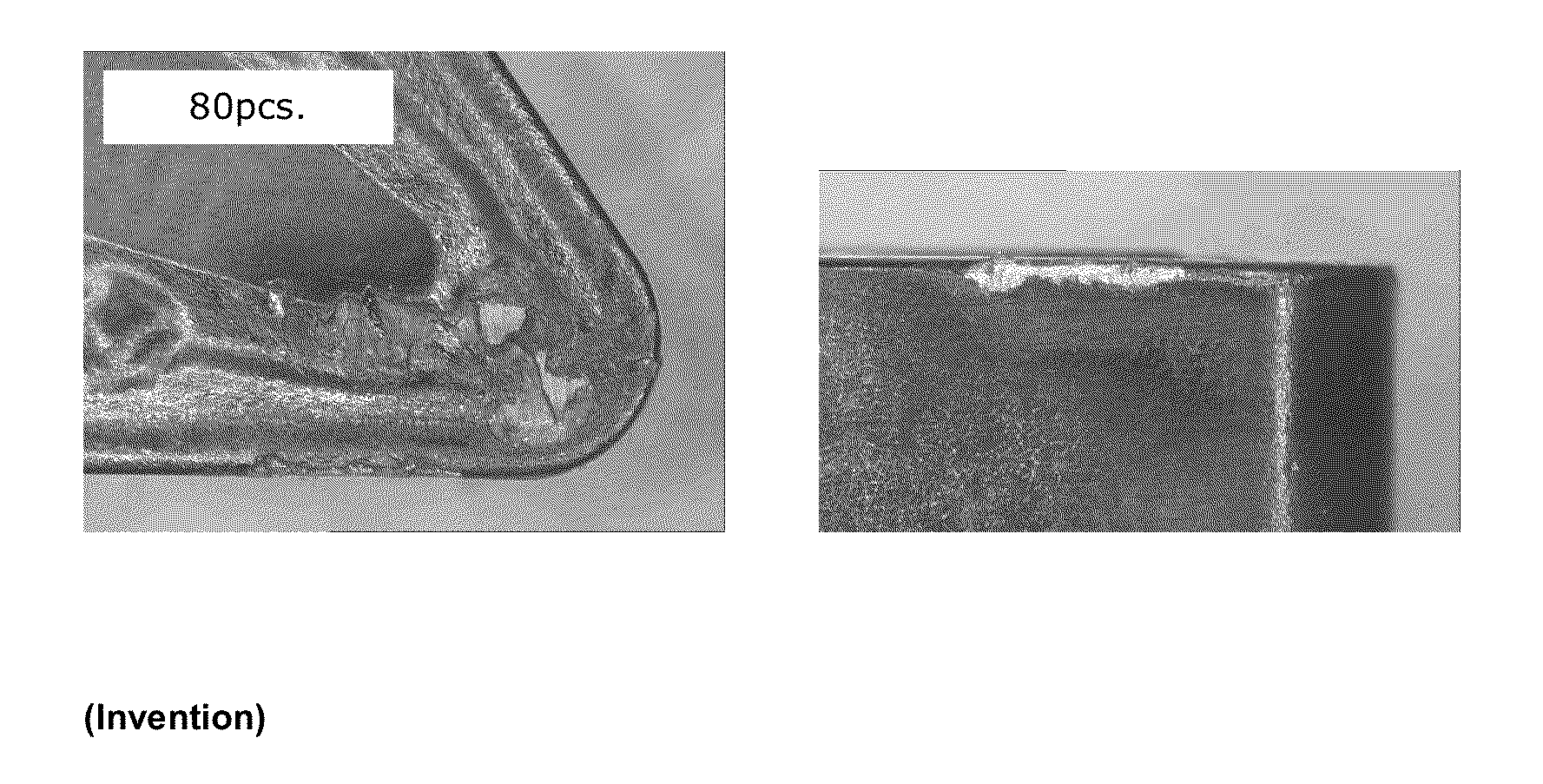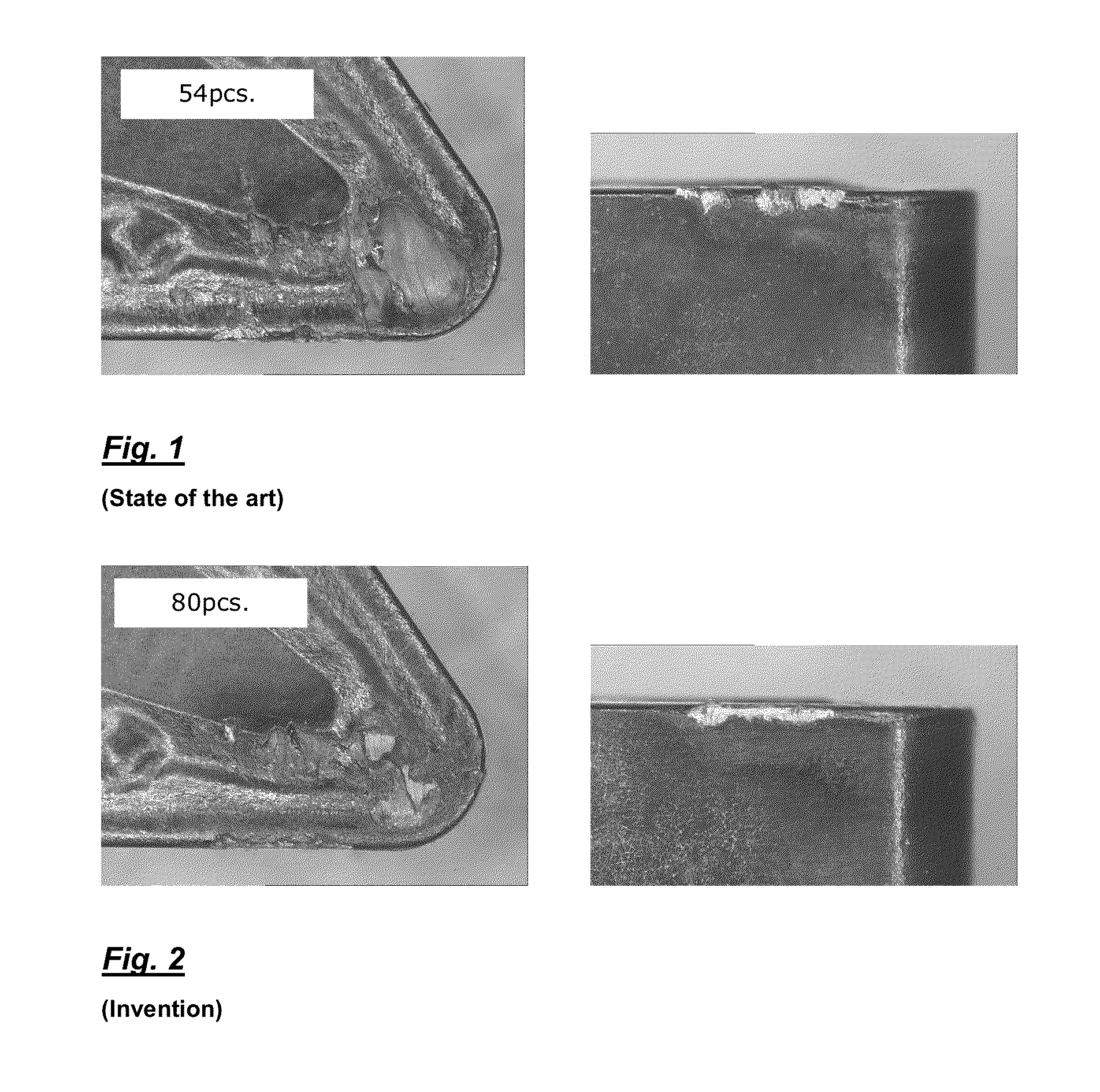Cutting Insert and Method for Production Thereof
a cutting insert and cutting technology, applied in the field of cutting inserts, can solve the problems of cutting insert wear resistance, cracks and fractures in the coating perpendicularly, adhesion problems, coating spalling, etc., and achieve excellent wear resistance, high wear resistance, and loss of toughness
- Summary
- Abstract
- Description
- Claims
- Application Information
AI Technical Summary
Benefits of technology
Problems solved by technology
Method used
Image
Examples
example 1
[0066]WC / Co hard metal substrate bodies (indexable cutting bits of various compositions (HM1, HM2, HM3, HM4, HM5 and HM6) were coated in a CVD method in the layer sequence TiN-MT-TiCN-α-Al2O3—HT-TiCN with various layer thicknesses for the individual layers. A thin (2O3 layer. All coatings were produced in a CVD reactor of Bernex BPX325S type with a radial gas flow.
[0067]The MT-TiCN layer was deposited at a pressure of 90 mbars and with the following gas concentrations (percentages in relation to the gases in the CVD method denote % by volume): 2.0% TiCl4, 0.5% CH3CN, 10% N2, 87.5% H2.
[0068]A thin (2O3 layer in three process steps.
[0069]1. Ti(C,N)—duration: 20 min, temperature: 1000° C., pressure: 500 mbars, gas concentrations: 5% CH4, 2% TiCl4, 25% N2, balance H2
[0070]2. (Ti,Al)(C,N,O)—duration: 15 min, temperature: 1000° C., pressure: 75 mbars, gas concentrations: 5% CO, 1% AlCl3, 2% TiCl4, 25% N2, balance H2
[0071]3. (Ti,Al)(C,N,O)—duration: 5 min, temperature: 1000° C., pressure...
example 2
[0091]The cutting bits produced in accordance with Example 1 were used to subject camshafts to external machining in the interrupted cutting mode in accordance with the following test parameters:[0092]Work piece: camshaft[0093]Material: 16MnCr5 (Rm=600−700N / mm2)[0094]Machining; Lengthwise turning in the interrupted cutting mode; wet machining[0095]Cutting data: vc=220 m / min[0096]f=0.4 mm[0097]ap=2.5 mm[0098]Tool geometry: DNMG150608-NM4[0099]Tool life: State of the art: cutting insert 11 according to Table 5: 54 components[0100]Invention: cutting insert 14 according to Table 5: 80 components
[0101]FIG. 1 shows the tool according to the state of the art (cutting insert 11 of Table 5) after the machining of 54 components. After the end of the tool life both crater wear and also notch wear and break-out phenomena at the cutting edge are to be seen. Crater wear is a typical form of wear when turning steel materials, occurring because of a lack of wear resistance at...
example 3
Cutting Machining Tests
[0103]Cutting bits produced according to Example 1 were subjected to the so-called strip turning test (test using a severely interrupted cutting mode). In that test the toughness characteristic of indexable cutting bits is investigated, by a shaft equipped with four strips of heat-treatable steel being machined in an external lengthwise turning process. The strips which in that case are subjected to cutting machining represent only a part of the periphery so that a severely impacting action takes place on the tool cutting edges. The life of the tool is determined as the number of entries into the workpieces until failure of the cutting edge due to fracture (impact count).[0104]Material: 42CrMo4; Rm=800 N / mm2 [0105]Machining: Lengthwise turning in the interrupted cutting mode; dry machining[0106]Cutting data: vc=170[0107]f=0.32 mm[0108]ap=2.5 mm[0109]Tool geometry: CNMG120412-NM4[0110]Tool life / impact count (respective mean value from 6 tested cutting inserts):...
PUM
| Property | Measurement | Unit |
|---|---|---|
| thickness | aaaaa | aaaaa |
| thickness | aaaaa | aaaaa |
| thicknesses | aaaaa | aaaaa |
Abstract
Description
Claims
Application Information
 Login to View More
Login to View More - R&D
- Intellectual Property
- Life Sciences
- Materials
- Tech Scout
- Unparalleled Data Quality
- Higher Quality Content
- 60% Fewer Hallucinations
Browse by: Latest US Patents, China's latest patents, Technical Efficacy Thesaurus, Application Domain, Technology Topic, Popular Technical Reports.
© 2025 PatSnap. All rights reserved.Legal|Privacy policy|Modern Slavery Act Transparency Statement|Sitemap|About US| Contact US: help@patsnap.com



